The refrain, since September 26, that “Eric Adams became the first sitting mayor in modern New York City history to be indicted,” has come with some reflection on former mayors who were engulfed in scandal but not indicted, or indicted but in pre-modern New York (or who weren’t sitting). While any verdict might be a while away—it’s been thus far painful to watch the mayor promise to “reign” instead of “resign”—the indictment is already historic, but not really unprecedented.
“I do not believe that in the grand, corrupt history of this city, this is the first mayor to have committed federal crimes,” Elie Mystal said on the Brian Lehrer Show—pointing out the dubiousness that the city’s second Black mayor is only the city’s first mayor to commit a federal crime. “Jimmy Walker was there, was a thing,” Mystal added. The parallels between Eric Adams and Jimmy Walker were already apparent enough. The showy attire. The nightlife. The ‘20s. Now we can add alleged acceptance of gifts in exchange for favors. The Walker drama did not end in an indictment, true, but I see that as a technicality. Maybe blame it in part on the fact that Samuel Seabury, who led the investigations, was not a U.S. Attorney, but a judge (not sitting) appointed to lead a committee. His dogged probe resulted in a report, which put the question in the governor’s lap. The governor (Franklin D. Roosevelt) judiciously took his time interrogating Walker (these were considered removal proceedings) but before he concluded the process, Walker (on former governor Al Smith’s advice) resigned. Walker then criticized Roosevelt, his own party’s nominee for the presidency (just like Adams saying the Biden administration was out to get him during a presidential race), and a week after resigning, sailed to Europe.
Some other mayors whose names surfaced since September 26: Bill De Blasio, who survived an investigation; Ed Koch, who did not win a fourth term for mayor after scandal surrounded his office; William O’Dwyer, who resigned during a growing investigation and took a US ambassador job in Mexico, and—did I leave anyone out?—you have A. Oakley Hall, who did get indicted in 1872 but was not convicted (or sitting) back in what I guess was pre-modern New York City.
But who cares about all the New York City-related political non-mayors who were investigated, indicted or even convicted? I can’t speak to the grand, corrupt history to that end but city-based Albany figures: Andrew Cuomo, Sheldon Silver, Malcom Smith, Dan Halloran and Eric Ulrich come to mind. I guess there just is no comparing to an indictment of a New York City mayor, but I thought I’d use this moment to highlight an indictment (and conviction) that I’ve dug from the vaults of Queens history, a precursor of sorts to the Seabury investigations, because it seems unfairly forgotten.
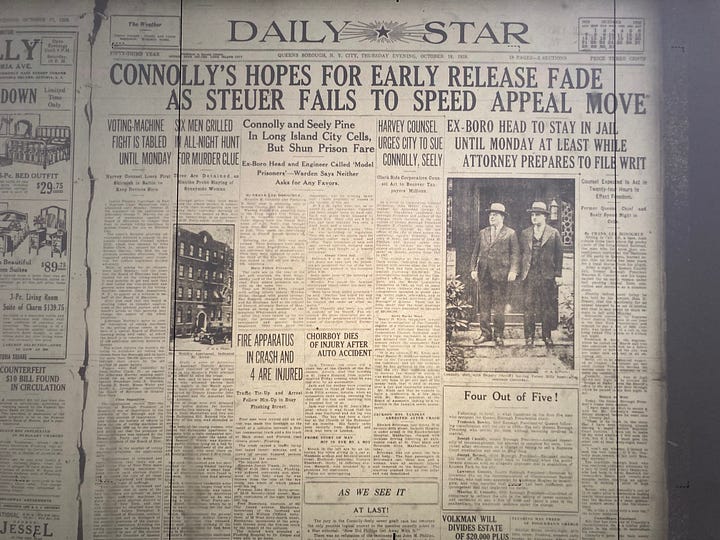
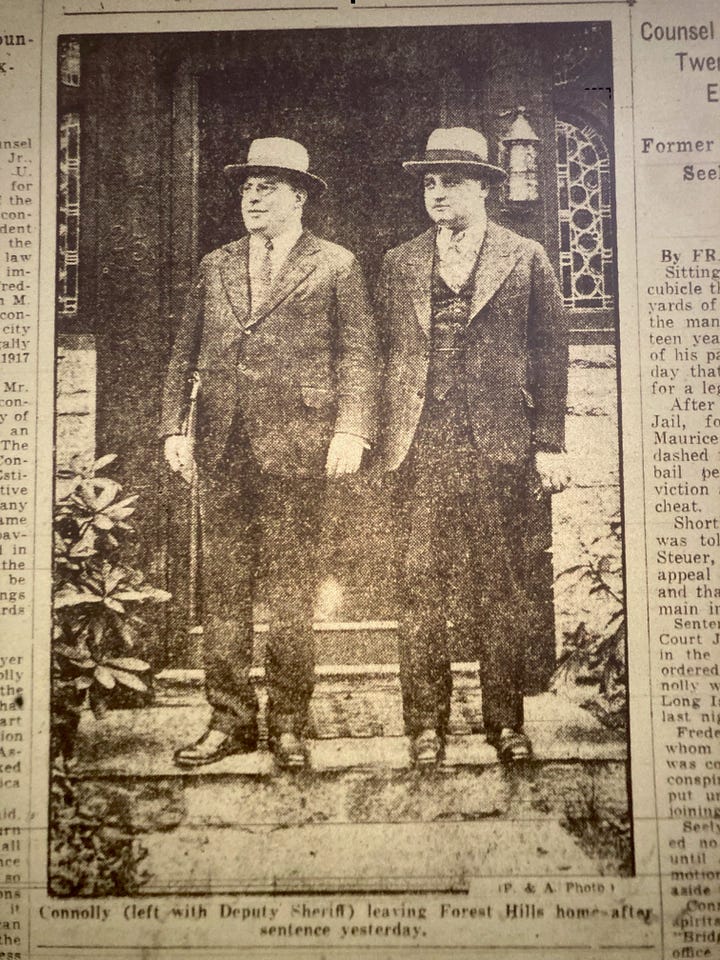
I think the indictment of Queens Borough President Maurice Connolly is worth dredging up—Connolly’s story gets lost, even, I guess, under later borough presidents, such as Queens’ Donald Manes, the Bronx’s Stanley Simon and, well, Brooklyn’s Eric Adams—because Connolly actually helped build Queens on graft. We don’t think of borough presidents having all that much power, but until 1989, they took up five seats in the eight-person Board of Estimate, the central governing body of the city. In the first few decades of the 20th Century, they were of major consequence as borough builders. And before Queens, where I’m writing this, had the cozy reputation as the “World’s Borough” for its epic diversity, New Yorkers knew it better as a wildly corrupt place. Even in 1984, Jimmy Breslin exaggerated that Queens was “a county that is still famous for having its first six borough presidents indicted.” (In reality, Queens’ second president, Joseph Cassidy, was indicted, its third president, Joseph Bermel was investigated, and its fourth president, Lawrence Gresser, was removed by the governor).
If you look around Queens, almost everything you see—likely most of the housing, anyway—was built while Maurice Connolly was borough president. Most of that landscape was built during a population boom and a real estate development phenomenon on a scale never seen anywhere else in the city or at any other time. Maurice Connolly was responsible for the infrastructure—the street pavings, the street lights, the schools, postal buildings, court houses and the sewers.
The sewers were critical because the infrastructure did not keep up fast enough with the growing population, which suffered heavy rainstorms that caused traffic accidents and flooding of hundreds of houses. All throughout the 1920s, a time when the Queens population doubled to about a million people, Maurice Connolly used sewer construction contracts to line his own pockets—and made Queens residents suffer in the process.
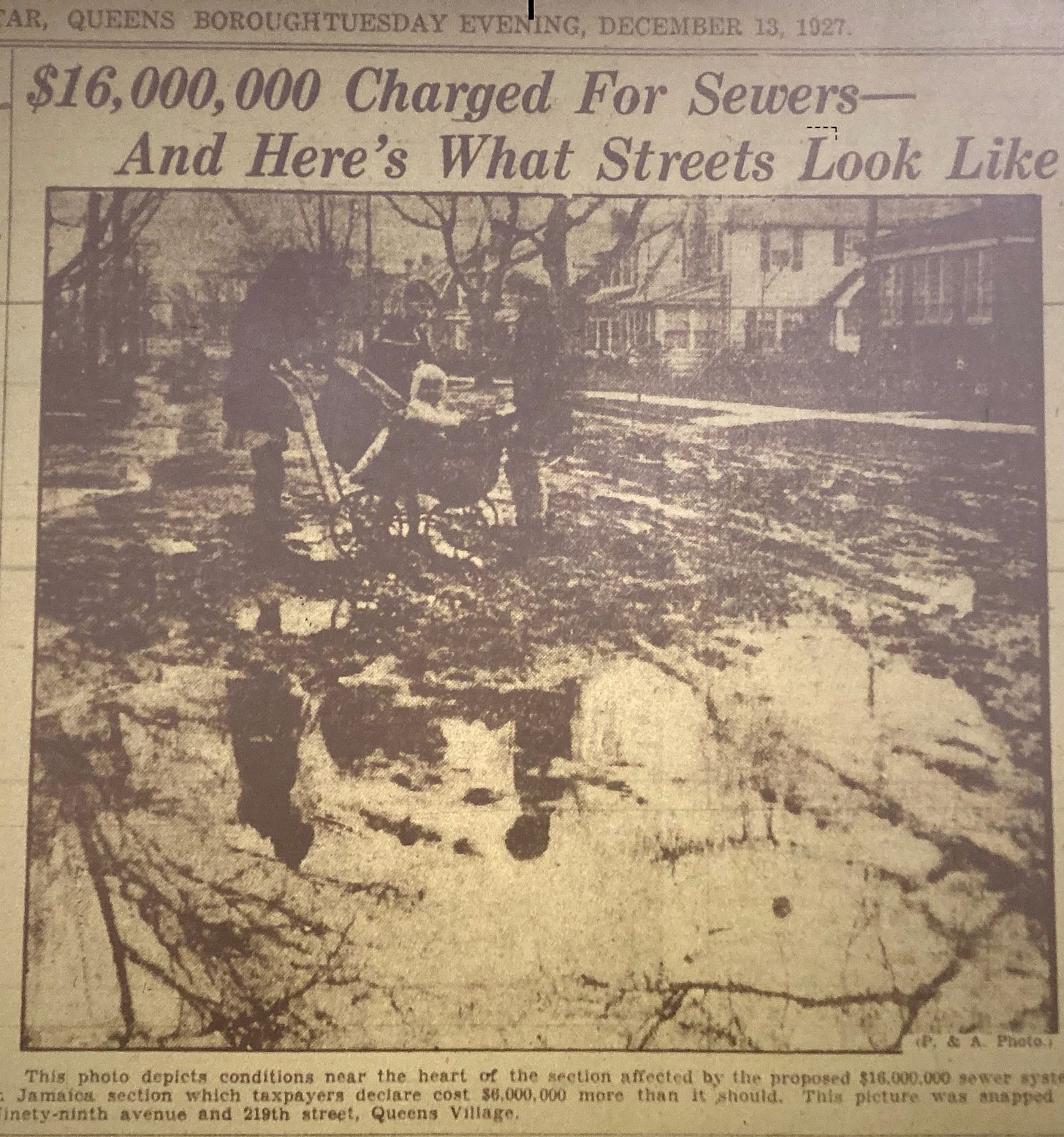
After Governor John Adams Dix removed Borough President Lawrence Gresser, the borough’s aldermen chose Connolly, a Corona-born son of Irish immigrants and former judge, to fill the vacancy. In 1913, Connolly ran on an anti-Tammany, Democratic ticket and stayed in power another 14 years. In 1921, a city election year, Republican State Senator Schuyler Meyer led an investigation into Mayor John Hylan’s administration, and Connolly’s Republican opponent in the upcoming election tipped off the committee to Queens sewer contracts. Connolly’s office got raided. The committee also subpoenaed Connolly’s affiliate, John M. Phillips, who’d been indicted several times before, including in connection to a borough contract. He’d also been fired as a state hospital inspector for supplying hospitals with spoiled meat.
Testimony suggested Connolly conspired with Phillips, who had a patent for the “Lock-Joint” sewer pipe specified for Queens sewer construction. The testimony suggested Queens paid 321% above average for the pipe. According to testimony, a separate contractor for sewer construction backed out after being pressured to pay $25,000 to Connolly’s supreme court campaign. Phillips, the testimony said, brokered a transfer of the contract to a new contractor, telling the new contractor to pay the first one $14,000 in cash, made out to him (Phillips), but the first contractor refused. “This money has been promised to Connolly and I must have the cash or something terrible will happen,” Phillips was quoted as saying. At a later hearing, an insurance agent said the first contractor told him he paid $50,000 to fast track contracts and get more contracts. When a lawyer asked the agent what was the position of John M. Phillips, he said, “I always heard him spoken of as the unofficial head of the Queens sewer department.” Asked who was the actual head of the sewer department, the agent replied, “I don’t know. I never heard of any.”
As a journalist recapped later in the 1930s, the contractors had later changed their stories. Connolly won reelection.

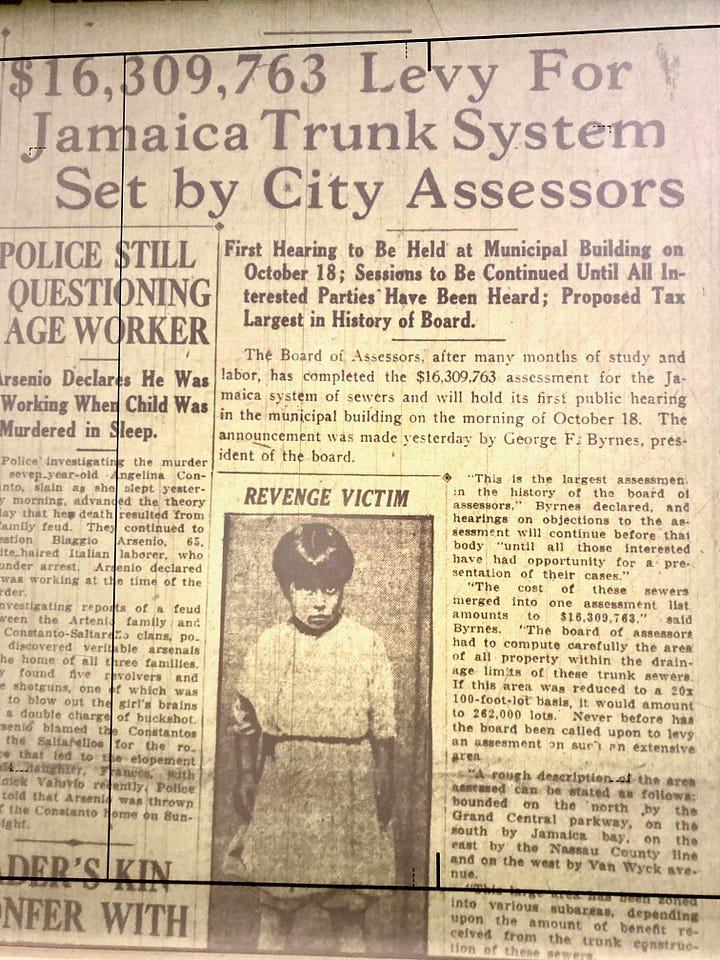
In September 1927, news broke of a Jamaica-area sewer system that would cost more than $16,000,000, the most expensive local infrastructure tax ever to come before the Board of Assessors. This resulted in assessments billed to local homeowners, most at more than $100 or $200. (Adjusted for today, a typical bill would be about $2,250.) “Most of these were poor people and workers who had bought their homes on allied ‘easy payments,” the Brooklyn Daily Eagle would explain later. “Some, because of the oppressive assessments, had to give up their homes; others met the hardships by stinting on the butcher’s, doctor’s and clotheir’s bills; the loan sharks got others.”
A coalition of Queens civic groups hired a lawyer, Henry Klein. At a packed Board of Assessors meeting, Klein submitted an affidavit charging “more than four million dollars [was] paid over and above a fair and reasonable profit” for the sewer. In subsequent hearings he said contractors told him they were coerced into making cash payments for Phillips’ patented pipe, and that Queens officials were planning more sewers using the pipe. It was reported that the same pipe sold to Bridgeport, Connecticut in 1925 for $5.25 per foot but sold to Queens for up to $108 a foot. Klein argued that the Connolly ring squeezed $6,000,000 of graft from the Jamaica sewer and projected that Queens corruption under Connolly amounted to $50,000,000 to taxpayers. In one, highly covered hearing, Klein grilled the lead engineer for four hours to show his incompetence. He called on Mayor Walker to investigate the Queens administration at large. By the end of 1927, Klein received death threats.
George U. Harvey, a Flushing-based Republican alderman who would later become borough president, called on Governor Al Smith to launch a state investigation, and submitted to him Klein’s charges. Smith appointed a judge—initially Supreme Court Justice Townsend Scudder, who had also overseen the Ruth Snyder case, but later replaced him with Clarence J. Shearn—to hear the charges, which included “Gross waste of public funds by exorbitant payments to contractors to which they were not entitled.” Twenty six sewer contracts and all public works contracts going back 13 years were under scrutiny. Shearn’s report to Smith alleged “gross neglect of duty and criminal waste of public funds.”
Within a week of the state-led public hearings in April 1928, Connolly resigned. At a hearing of the grand jury in June, Connolly, dressed in a brown, pin-stripe suit, arrived late, jumped out of a sports car and ran into the courtroom, where he smiled and bowed. The grand jury indicted Connolly, Phillips, the head sewer engineer and a contractor. The charges involved three counts of conspiracy. A federal investigation into Phillips’ income tax led to charges that he owed the government $2,700,000.
A few weeks later Phillips was found dead in Atlantic City after a drinking binge. A month after that, a guy who allegedly knew too much was found dead in Harlem. In September, a key witness was found between Calvary and Mt. Zion cemeteries with a bullet in his head.
Queens citizens, the New York Daily News reported, showed “astonishing willingness” to serve on the jury against Connolly at the Long Island City Courthouse. One witness testified that Connolly, who only received a $30,000 salary, paid her real estate agent in cash installments between 1925 and 1927 for a $145,454 property in Forest Hills. Others said he purchased more real estate in Forest Hills, Flushing and Corona. The prosecutor, Emory Bruckner, made the case that since 1917, nine-10ths of Queens sewer jobs were done under specifications for Phillips’ pipe. Bruckner charged that Phillips set up a market in 1926 for sewer contracts, profiting off whomever would pay the most for the deals, approved by Connolly without process. The jury found Connolly and the head engineer guilty of conspiracy to defraud New York City.
Connolly and the engineer spent a night in the Long Island City jail behind the courthouse, smoking cigars. They were taken the next day to the penitentiary on Welfare (Roosevelt) Island but Connolly walked free the next morning on $5,500 bail.
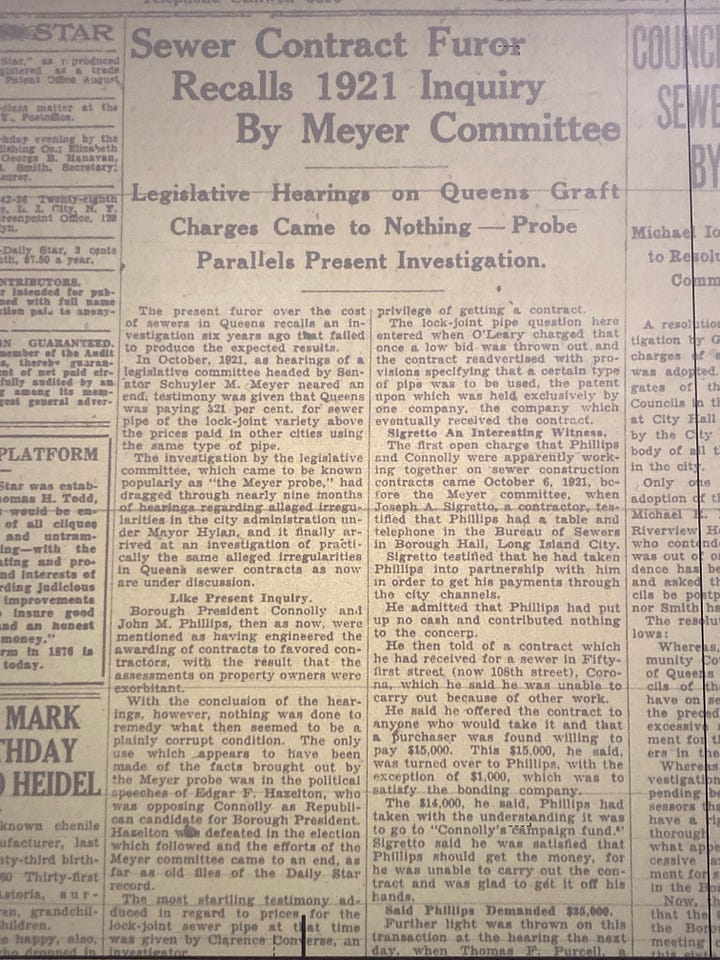
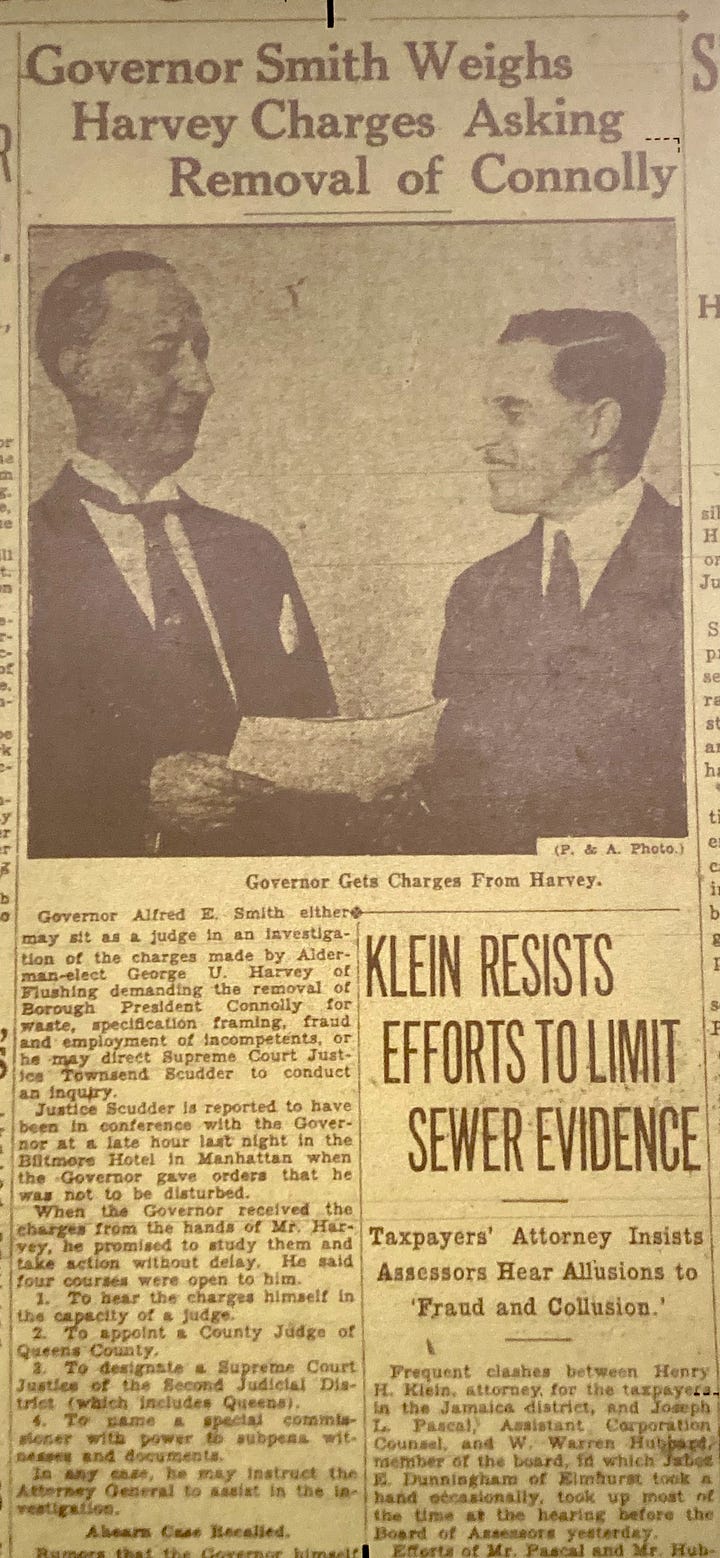
Two years later in October 1930, in the midst of economic collapse, Judge Seabury began hearings investigating the then-magistrate court system, which led to his investigations into the Manhattan district attorney and then, by 1931, the city government at large. The fact that Mayor Walker wasn’t indicted was in a way beside the point. The city by then, with unemployment at a record high, was in the hands of the banks, in desperate need of rescue. The investigations, and the state of things, revealed not only the mayor’s lack of integrity, but the pervasive culture of corruption. Seabury interrogated the county bosses, including Queens’ Democratic boss John Theofel, who took over from Nathan O’Smedley after Connolly resigned. Seabury revealed that corruption continued in Queens but in a less punishing way, in the same vein that corruption was soaked into everything.
We do not remember Maurice Connolly, I think, because his scandal happened in 1927, and it happened in Queens. I think you can say the larger citywide Seabury investigations, along with all the profound drama that followed in the 1930s and 40s, easily overshadowed the Queens sewer scandal. That said, 113 years after the Triangle Shirtwaist Factory fire, Mayor Adams is accused, among other things, of pressuring the fire department to sign off on a 35 story tower that was held up over serious fire safety concerns. That, if you ask me, is an indictment to remember.





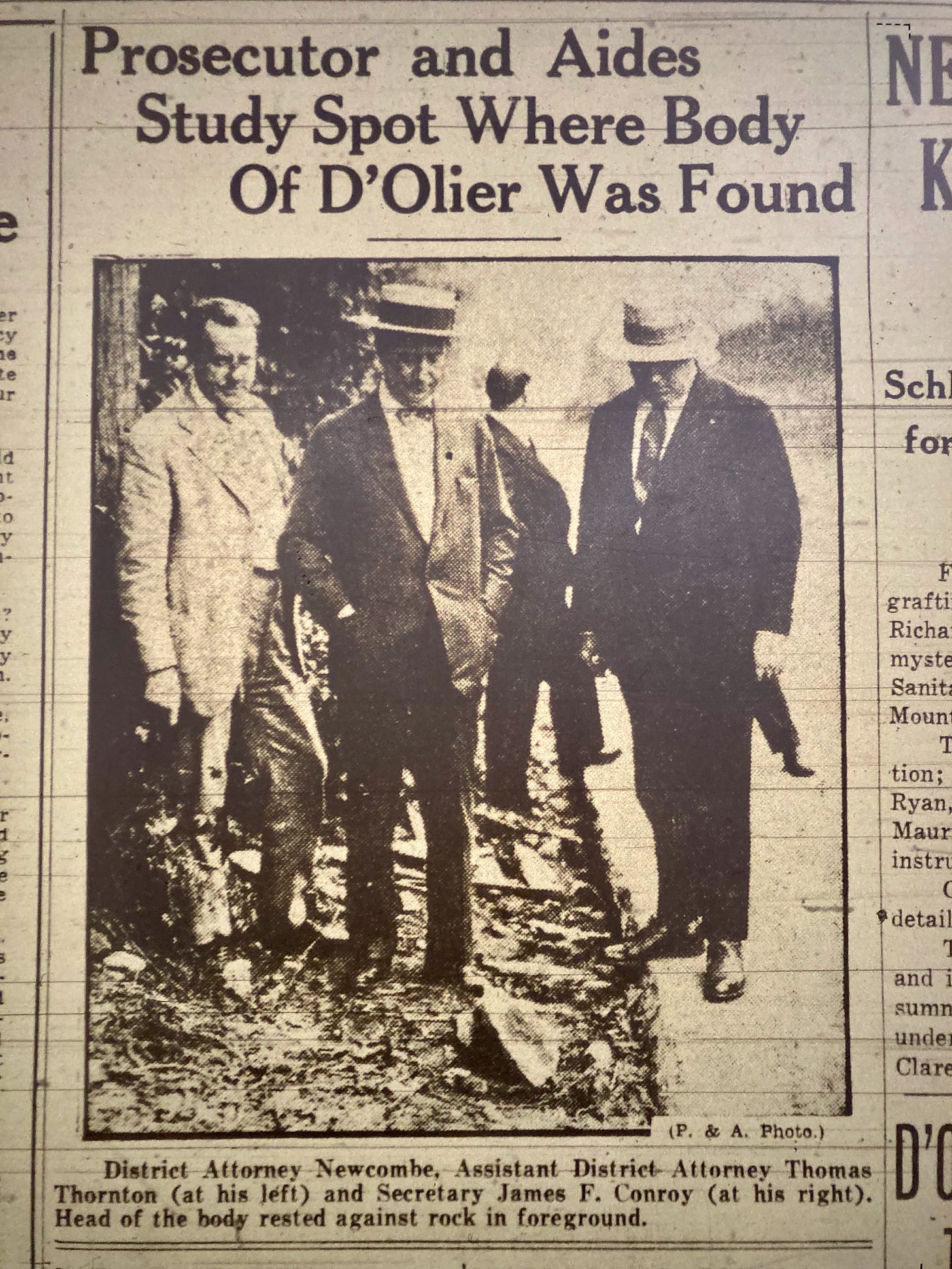
Hi Shannon - I enjoyed your article about n Maurice Connolly - somewhat accurate but more from a different perspective. M. Connolly is my Great Grandfather - his only child Helen was my Grandmother . Maurice was convicted on circumstantial evidence and was released after a year served on Rikers Island. Thank you for writing the article, Mike